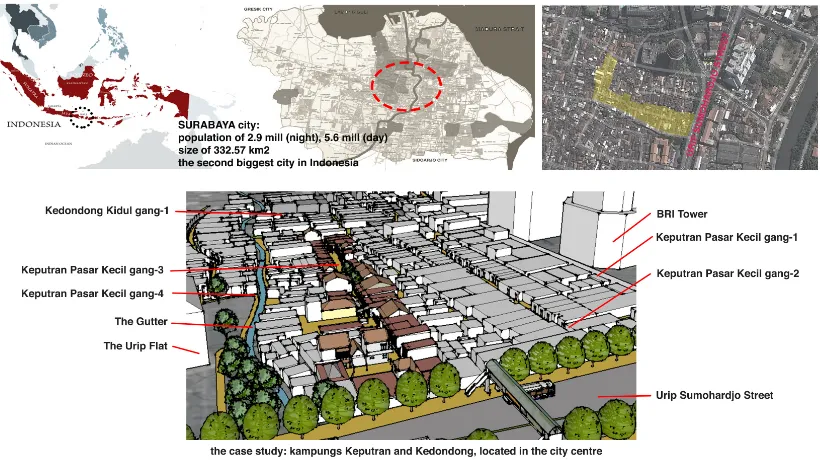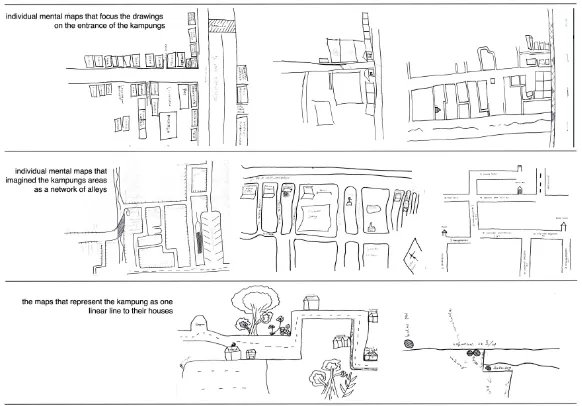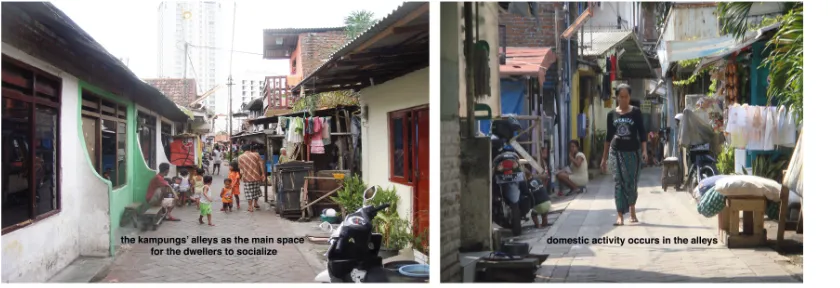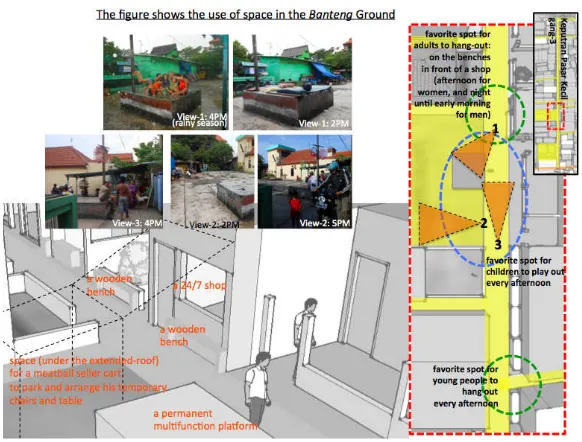images as a result of people’s memories and meanings (Lynch 1960). The urban elements are read or analyzed into three categories: psychological feelings to their environment such as attachment, warmth, relaxation and interest (Lynch 1990).
high economic value and accessibility. On contrast, most kampungs in Indonesia today are located in left over areas of the city and face a complicated social and political problem. Spatial and economics discrimination are triggered by urbanization and industrialization process within cities (Lefebvre 1996); while political changes and economics segregation of a city creates marginalization of kampungs (Kusno 2000). The focus of third space understanding is on the development of cultural hybridization through a process of discrimination and exploitation of class, gender and ethnicity. This is the process of third space creation in contemporary cities, especially for Indonesian cities. The meaning of place could be understood through the third space exploration.
The manuscript file should be as complete as possible. This means that the images, figures, tables, endnotes and bibliography will have to be placed within the script file as the author wishes them to appear in the final published article.
If the author is using additional tools (such as EndNote or Excel) to create references or tables and figures, the mounted elements should be as simple and as stable as possible. This is accomplished in slightly different ways for different programs, and for this reason, the journal requests that the author secure local help with these elements before the files are submitted. If this is not possible, the author should alert the editor about this matter prior to submitting the manuscript. In all cases, submissions should be in word files.
THE CASE STUDY OF KAMPUNGS
The observation of meaning through the third space understanding is explored in the case study of kampungs in Surabaya in Keputran. The kampungs are: Keputran Pasar Kecil gang 1 to gang 4 (gang=aisle/alley), and kampung of Kedondong Kidul gang-‐1. The main access entering these kampungs is from Urip Sumohardjo Street, except for Kedondong Kidul gang 1 kampung. It is the main street of the city and creating a spine of the city street structure.
Keputran Pasar Kecil gang 1 is located directly in juxtaposition with the BRI Tower, and gang 4 is side by side with the Urip Flat. Between Pasar Kecil gang 3 and gang 4 is the location of the gutter/silted channel. The 4 meter-‐pedestrian of the main street is physically separated the kampungs’ entrances with the main street. It also connects the kampungs with the shops and kampungs areas opposite them through the pedestrian-‐bridge over the main street. Shops, banks and other commercial facilities are grown along this pedestrian. Especially in the afternoon (after working hour), many food/beverages hawkers occupy the pavement. It is also functioned as parking areas for motorbikes and becaks (becak=pedicab) to ride and park.
Figure 2: The pedestrian way of the main street (pedestrian, becaks, motorbikes, hawkers, trees etc)
The kampungs are placed side by side with a high rise building of BRI Tower with modern style and beautiful garden in the Basuki Rahmat area. The two are separated by a long permanent wall belongs to the modern building, and the spaces inside the wall are used as parking or service areas. Contrary, another side of the wall is a living space for kampungs’ dwellers, which is characterized by one-‐storey buildings, semi-‐permanent, and organic pattern of housing layout and street with organic infrastructure provision. The area inside the wall is for commercial use and was planned and designed professionally, while behind the wall is for human who live by surviving on a day to day basis.
Figure 3: The commercial district and the kampungs
Figure 4: The mental maps
In order to understand the conceived space of the kampungs, the exploration of the individual mental maps and the map compilation show that the spatial and elemental preferences of the young adults are focused on the path structure, especially the main alley of his/her kampung and smaller alleys as its branches. The way they drew the paths is also the way he understood the path. They recognize the main street in terms of transportation and speed; there is no direct connection with houses/ buildings that face the street. On the other hand, the alley has a strong connection with the houses/warungs, the alley comes after the houses development, and therefore the path that is formed follows the space left after the houses development. In addition, the social connection between houses and the alley is strong, the houses are private space and the alley is the semi-‐private space.
The kampungs’ alleys are memorized in two conditions: the structure and the order dimension related to the alleys’ names (gang 1,2,3 etc). They imagined the kampungs’ structure in three degree of importance: the most important is the alley where his/her house is located, alleys that connect their neighbourhood to the main street, the types of connecting alleys, and the last is the dead-‐ end alleys. In the individual maps, they know most all of the kampung details along his/her alley: the number of houses, colour of the benches, members of groups that hanging out in specific areas, any trees and greenery. The closer the elements to his/her kampungs’ alley and alleys connecting to the main street, clearer and more detail elements memorized by them. The focus of their mental map drawing is not on the location of individual houses (as commonly done), but on the alley of his/her kampung as the main location of social activities.
important landmark. The kampungs’ dwellers (mostly from Keputran Pasar Kecil gang-‐1 to 4, and Kedondong gang-‐1) believe that these graves belong to their ancestor. Although the grave is inaccessible for the public (only open for the kampung leaders), the young adults respect this grave because of its historic sacredness.
The young adults have strong preferences along the main alley especially spots for social meeting or hanging out for kampungs’ dwellers. A Specific group occupies a specific spot at a specific time in a day. In the day-‐time, groups of children and women occupy spaces near the open space (the Bull’s ground), while at night-‐time men from the kampung and outside do their social activity at this spot. Every group has their specific territory at a particular time in the alleys and open spaces. This explicit agreement is understood and agreed by the kampungs dwellers, they never occupy any other groups.
The kampung’s territory is seen by the young adults within the boundary of BRI Tower, parking area of BRI, the main street (and the pavement), Keputran Market, Urip Flat, the gutter, and also other kampungs. Other kampungs that are attached to the two kampungs, namely kampung Kejambon, Panjunan and Among Siswa,; are also strong elements to bound their territory. These kampungs border their kampungs, and they said that these kampungs are unsafe, ugly and too quiet. The gutter is an important element of navigation; despite its poor visibility being covered by dense houses on both sides. Keputran Market is memorized by them in terms of the working place for most kampungs’ dwellers and for the feeling of danger because people from the market like to get drunk and have brawls in the kampungs.
In conceptualized their kampungs through maps, the focus of their map is not on the location of their houses, but on the alley of his/her kampung as the main location of social activities. In memorizing the alley, it differs based on the social spots: closer to the spot, more detail the elements been memorized. Empty spaces, greenery, and public facilities elements are also related to the social activity in the alleys, besides its factor of visibility and vitality. In terms of sacredness, the elements of the ancestor’s graves are important; this is the only element that is absent from the young adults’ experiences factor. Elements that are also absent from the social activity relationship and/or related to negative social meaning are elements that bordered the kampungs’ territory, such as the gutter, the flat, the market, and the tower. These observations are based on a qualitative approach; however quantitatively, the two most mentioned are the cyber café and the areas around the warung of pak Tris.
The Third Space
In exploring the third space of the kampungs, this research observes the historical background of Keputran Kampungs before and after Independence in order to understand the current physical condition and social characters of the dwellers that are inherited from the past; and the exploration of the daily the rhythm of the kampungs’ daily life.
The kampungs of Keputran is older than the city itself or the same old with the Soerabaja Kingdom. Based on the map of 1678, the name of kampung Keputran had been appeared. Before the Independence, the kampung often has conflict with the landlords because the regulation of tax payment. In approaching the Independence, the kampung has significant role especially in protecting the city (or the nation) from the British troops. The kampungs’ dwellers are commonly known as their ‘arek’ spirit in defending the city with traditional weapons of bamboo runcing (bamboo runcing = sharp bamboo branch). The spirit or personal character of ‘arek’ is embedded with the Surabayan young people especially from kampungs until today.
After the Independence, all kampungs in the city are the place for immigrants from outside the city who occupy provided permanent houses or built non-‐permanent houses (slumming). Under the Kampung Improvement Programmes (KIP), the physical condition of kampungs in Surabaya was improved especially in providing concrete slabs for the alleys, public toilets, water supply and drainage. Instead of better living condition of kampung, the kampungs’ dwellers have been offered compensation from an office rental management to sell their land for the project of the extension of the business district. It was only some of the dwellers agreed with the compensation, but mostly not. Therefore, the negotiation between the management and the dwellers are continued until today.
Figure 6: The kampungs’ alleys
Figure 7: The use of space in Banteng Ground
The observation of lived space as above shows that in historical perspective, the character of ‘arek’ that is now being represented by the ‘Bonek’ character is embedded with their personal character of being free. ‘Bonek’ is a name for the fanatic fans of Surabaya football club. In current condition, ‘Bonek’ is known through its reluctance character when there is a football match. The issue of eviction is giving them an uncertainty feeling of living in the kampungs. Instead of the KIP programmes, the dwellers feel ignorance from the local government, because the continuation of slumming process and the changing use of domestic to commercial uses. In terms of space usage, the alley is a meeting point of the community according to time, social activity and social group. It offers a multifunction usage and social structure that is merged and overlapped between private and public, and business and leisure needs.
DISCUSSION OF THE THEORY EXTENSION
Through the exploration of the first-‐second space and the third space as above, it could be summarized that in understanding urban spaces, meaning is more important than legibility of urban elements. Kevin Lynch’s theory put emphasis on the legibility as the most important factor in evaluating and designing high quality urban spaces. In urban areas such as the kampungs when the physical and social conditions are in contrast with the city around them (identity crisis), the social life observation is more beneficial than legibility observation especially for the purpose of planning/design strategy. It is because the kampung is naturally built by the original people of the city for their life survival, which with less consideration from the local government at each stage of development.
their social life rather than only its physical characteristics. The third space observation explores the cultural layers through the daily
Koseoglu, Emine, and Deniz Erinsel Onder. 2011. “Subjective and Objective Dimensions of Spatial Legibility.” Procedia-‐Social and Behavioral Sciences, Elsevier 30: 1191–95.
Kusno, Abidin. 2000. Behind the Postcolonial; Architecture, Urban Space and Political Culture in Indonesia. Architext Series. London: Routledge. Difference, Everyday Life; Reading Henri Lefebvre, edited by Kanishka Goonewardena, Stefan Kipfer, Richard Milgrom, and Christian Schmid. New York: Routledge.
Soja, Edward. W. 1996. Thirdspace; Journeys to Los Angeles and Other Real-‐and-‐Imagined Places. Oxford: Blackwell Publisher.





